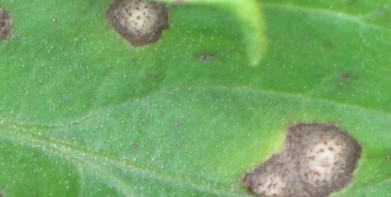By Beth K. Gugino
Septoria leaf spot on tomato
The general shift to drier weather has slowed down disease development across the state.
This past week there have been additional reports of downy mildew on cucumber on the Delmarva Peninsula in Kent County, Delaware and Wicomico County, Maryland. Current weather patterns do not indicate movement into our region. However, regular scouting, especially in southeastern Pennsylvania, is important. No new reports of late blight since the confirmations on tomato in York County and on potato and tomato in southern Lancaster County last week. Blackleg on potatoes continues to be a problem in some parts of Pennsylvania.
Common Mid-Summer Tomato Diseases
Early Blight and Septoria Leaf Spot
Early blight and Septoria leaf spot are two fungal diseases commonly seen in tomato fields as the plants start to fruit. Both start on the lower leaves when spores are splash-dispersed during rain events and work their way up the plant leading to defoliation. Early blight lesions are initially small, brown to black, and may be surrounded by a yellow halo. As the disease progresses, larger lesions will develop a characteristic concentric ring pattern. Lesions with concentric ring patterns can also develop on the fruit and stems. Septoria lesions are circular with a tan center surrounded by a darker margin/border. With the aid of a hand lens, small black pycnidia (spore producing structures) can be seen in the center of the lesions. The lesions primarily develop on the leaves and not the fruit or stems. Both pathogens survive on crop residue, so shorter rotations lead to increased problems. Although early blight is favored by slightly warmer temperatures (75 to 85°F) and Septoria cooler temperatures (68 to 77°F), it is not uncommon to see both at the same time. In recent years however growers and other stakeholders have commented on the increasing predominance of Septoria leaf spot in tomato fields.

Small round lesions, a darker margin, and tan center are characteristic of Septoria leaf spot on tomato. Small dark pycnidia can be seen in the center of the lesions in this enlarged image.
Early blight lesion with concentric rings and characteristic yellowing.
During the season, maximizing air flow by suckering, staking and tying the plants as well as minimizing working the field when it is wet will help minimize spread. Mulching around plants to reduce soil splash may also help. Protectant fungicides like chlorothalonil, mancozeb, and Gavel will also help reduce spread, but good coverage is important. These are best rotated with products in FRAC codes 3, 7 or 11 including Quadris Top (FRAC 3 + 11), Revus Top (FRAC 3 + 40), Endura and Fontelis (FRAC 7), Priaxor (FRAC 7 + 11), etc. See the 2018 Mid-Atlantic Commercial Vegetable Production Recommendationsfor a more complete list of recommendations.
For organic production, copper-based products (e.g., Champ, Nordox, Badge X2) could be used in a program with plant defense activator products (e.g., Regalia) and microbial biopesticides (e.g., Double Nickel, Serenade, etc.). As with most product, these are best used preventatively. With funding support from the Pennsylvania Vegetable Growers Association and PA Marketing and Research Board this summer, the vegetable pathology program at Penn State is evaluating the integration of biopesticides into conventional programs coupled with host resistance for the management of early blight and Septoria leaf spot on tomato.